
5 Yoga Poses for Better Sleep
Do you struggle to fall asleep at night? You aren’t alone. In a 2020 poll, the National Sleep Foundation found that more than one-third of adults aren’t getting the recommended seven to nine hours of sleep each night. Respondents reported that lack of sleep affected their mood, mental sharpness, productivity, relationships, and overall health.
Sleep Quality
The American Academy of Sleep Medicine recommends sleep tips to improve your overall sleep quality. One of the most important tips is establishing a relaxing bedtime routine to combat stress. Daily and compounded stress leads to an increase in stress hormones, including cortisol, that affect how well you sleep.
The Role of Cortisol in Sleep
Cortisol plays a direct role in our sleep patterns, according to this 2015 study. Researchers measured cortisol levels in participants. They found that the lowest concentration of cortisol is around midnight, with levels increasing 2-3 hours after sleep onset and steadily rising into waking hours. Cortisol levels peak around 9 am and slowly decline throughout the day to encourage sleep.
In an individual with disordered sleep, these levels vary. Patients with insomnia present high levels of cortisol in the evenings and bedtime, which causes poor sleep. Poor sleep leads to even higher levels of cortisol and stress, which makes the following night’s sleep even worse. It’s a difficult pattern to break, but there are tools, such as yoga and meditation, that can help.
Why Yoga and Meditation?
A national survey found that yoga improved quality of life in many ways. Of those yoga practitioners surveyed, over 55% reported improved sleep quality and over 85% reported reduced stress.
Research supports this. A 12-week study in 2017 found that yoga and meditation can actually slow down, and possibly reverse, the pace at which we age by significantly decreasing levels of cortisol and inflammation. Other studies show that a consistent bedtime yoga and meditation routine can help improve your overall sleep quality by lowering cortisol levels.
5 Yoga Poses for Better Sleep
These 5 relaxing yoga poses may lower cortisol levels and help create a more restful mindset at bedtime. Start by practicing each posture for a minute or so, gradually working your way up to longer holds up to 5 minutes.
Seated Forward Fold
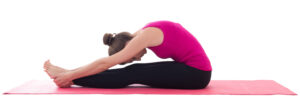
Sit up tall with your legs extended out in front. You may sit on a blanket or a pillow. Hinge forward at the hips. Reach your arms toward your toes, but it’s not necessary to touch them. The forward motion and stretch in the low back and hamstrings is the goal. Relaxing those muscles helps to relax the entire body.
Sphinx Pose
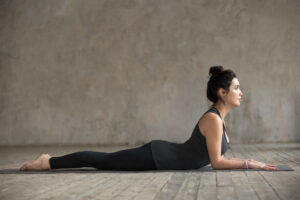
Lie down on your belly and untuck your toes. Activate the legs by pressing the tops of the feet into the mat. Lift the upper body and let the forearms and palms rest parallel to each other. Create space between your ears and shoulders. Press down through the palms, and imagine that you are pulling yourself forward on your mat. This pose helps to stretch the chest, shoulders, and abdomen, all excellent ways to reduce stress.
Child’s Pose
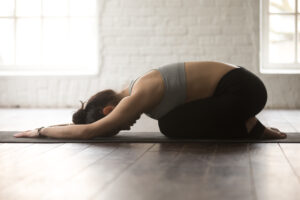
Start by kneeling. Let your big toes touch, and bring your knees as wide as is comfortable. Lower your upper body down between your thighs. Stretch your hands forward and rest your forehead on the mat or a block. Another great option is to use a yoga bolster for a supported child’s pose. Child’s pose can help promote better sleep and relieve tension in the lower back, chest, hips, and shoulders.
Supine Twist
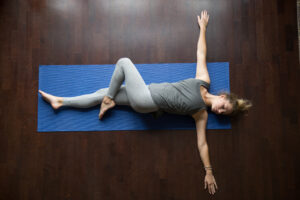
Lie on your back. Bend your knees and bring the soles of your feet to the floor. Let your arms open wide in a T shape. Scoot your hips over to the right side of your mat. Let your knees lower to the left. Hold this pose for a few breaths, then switch to the other side. You could also put a blanket between the knees.This pose can reduce stress, release a tight lower back and/or shoulders, and can help quiet the mind before bedtime.
Legs up the Wall
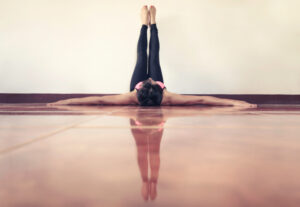
Legs up the wall is a gentle, accessible inversion. Start by sitting beside a wall with one hip touching. Begin to lower your upper body to the floor as you roll onto your back and stretch your legs up the wall. Adjust by scooting closer to the wall or by placing a blanket to support your low back. Find a comfortable position for your arms and legs to relax. This inversion can help improve circulation and reduce inflammation and stress and is excellent to practice before bed or when you wake up in the middle of the night.
More Practice
If you’re interested in more practice, check out our Yoga for Better Sleep channel on YogaVibes. We love this yoga nidra for relaxation, this cozy bedtime routine, and this restorative yoga practice (no props needed).